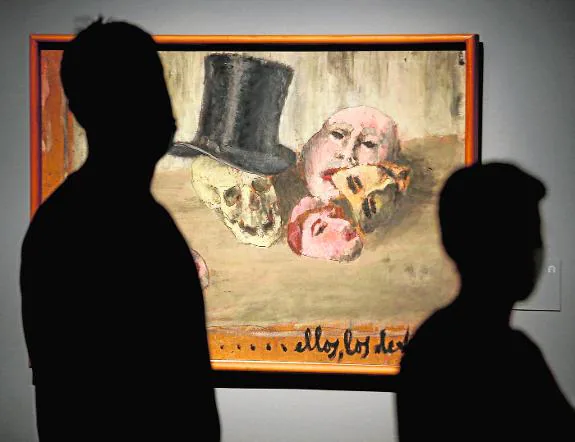

Sections
Highlight

REGINA SOTORRÍO
Monday, 17 August 2020, 13:43
Compartir
The similarities between the worlds inside and outside the paintings were unimaginable five months ago. Back then, everything was ready at the Carmen Thyssen museum in Malaga for the opening of the new temporary exhibition. This was the result of two years of study, focusing on the modern identity in painting, its concealment and transformation; but the pandemic came and halted the project due to open on 24 March.
Title. Masks. Metamorphosis of Modern Identity.
Venue. Temporary exhibition gallery at the Carmen Thyssen museum, C/ Compañía, Malaga.
Dates. Until 10 January.
Opening hours. Tuesday to Friday, 9.30am to 2.30pm and 5 to 9pm. Saturday and Sunday, 9.30am to 9pm. Monday closed.
Admission. 10 euros (concessions 6 euros).
Now it has finally seen the light, the faces of those contemplating these works by Goya, Ensor, Gutiérrez Solana, Maruja Mallo, Picasso, Modigliani and Julio González are covered, just like the faces looking out at them. The paradoxes of coronavirus.
Masks. Metamorphosis of Modern Identity, at the Carmen Thyssen Museum Malaga until 10 January, delves into the representation of the human face through 103 works of art travelling from romanticism to avant-garde.
The father of modern art, Francisco de Goya, opens the exhibition sponsored by Fundación Unicaja. Prints such as What Madness! lead us to a gallery of disturbing, disguised faces that make up the first section of the collection, entitled Disparates de Carnaval (Carnival Madness). Here the mask is still the heir of its classical conception, in the Commedia dell'arte, and is used as an object to hide an individual's true self.
This is the idea behind James Ensor's Theatre of Masks, with a frame that was designed deliberately to look like a stage.
The atmosphere gradually becomes darker and more mysterious with the grotesque figures by José Gutiérrez Solana - Carnaval en un Pueblo (Carnival in a Village), Murga Gaditana (Cadiz Street Musicians) - and the strange ambience that surrounds Eugenio Lucas Velázquez's Sermón de las Máscaras (Sermon of the Masks). There's something of Goya in all of these, that fascination for monstrosity; however the artist who points to Goya most directly is Nicolás de Lekuona. He died in the Spanish civil war at just 24, but left behind interesting works such as Ellos, los Detritus, where he focuses on the masks that Goya left piled up i n one of his prints.
The next section, Máscaras Sobrenaturales (Supernatural Masks) contains the most ambitious part of the exhibition.
Pablo Picasso's Étude pour Trois Femmes, on loan from the Paris Picasso Museum, is a highlight; as is the impressive The Mask Negro by Fernand Léger; and Paul Gauguin's sculpture Head of a Young Girl.
Rostros Transfigurados (Transfigured Faces) is the final part of this journey through identity, and this is where ambiguity comes into play. Figures are not clearly defined, and the faces merge with the masks to the point where it's impossible to tell where one finishes and the other starts. Chico in Top Hat by Walt Kuhn is one example, and the work chosen as the image of the entire exhibition.
This is, as defined by the exhibition's co-curator Luis Puelles, of Malaga University, a "strange [exhibition], full of compliments and discoveries". It is "honest - it doesn't sell what it doesn't have" and "unprejudiced, with great names, but above all great works of art".
These works have been loaned from 46 different collections; the show had to be "rebuilt" during the lockdown to be able to keep it on the museum's agenda, despite delaying the opening by four months.
Publicidad
Publicidad
Publicidad
Publicidad
Reporta un error en esta noticia
Necesitas ser suscriptor para poder votar.